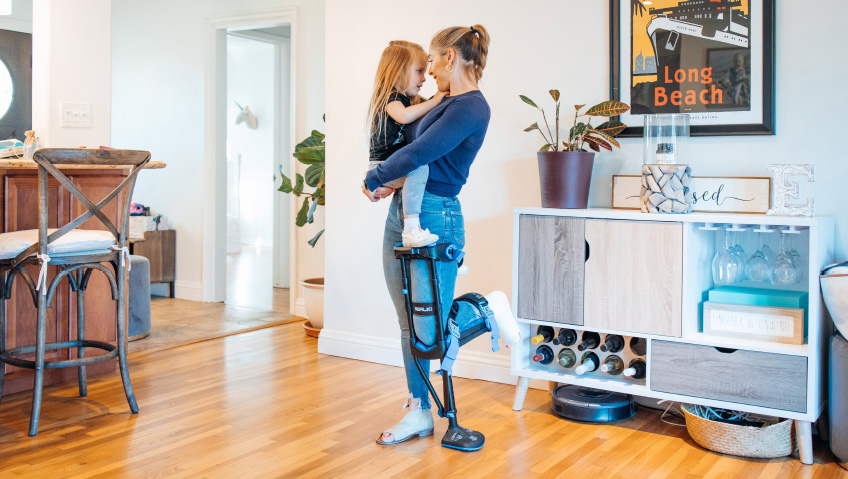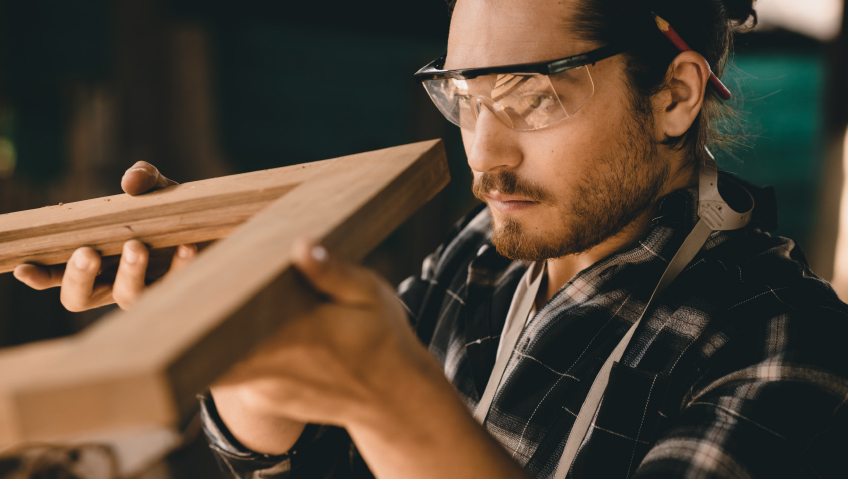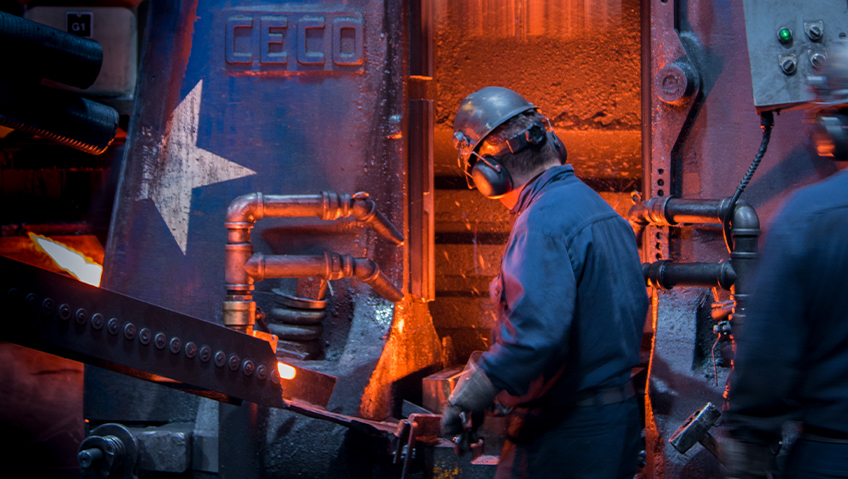It’s a product you don’t want to need, but sometime, maybe, you’ll be grateful it exists.
The iWALKFree is an FDA-registered crutch alternative offering unmatched mobility and releasing users from the grind, pain, and hassle of traditional crutches and knee scooters.
Whether you have a sprained ankle, Achilles injury, fractured foot or ankle, lower leg amputation, or any other non-weight-bearing lower leg injury, iWALKFree is a crutch substitute that offers an unparalleled level of movement, carrying out daily tasks and regaining freedom.
In 1999, a farmer from Ontario fell from his roof and broke his ankle. There’s no time off in farming, so, unable to do his chores on traditional crutches, he propped his knee on a stool and continued working. That was when the idea that it would be great if the stool could just move around with him popped up.
He built the original iWALKFree prototype from wood in less than an hour after his moment of creative insight. It allowed full use of his hands and arms, along with support for his injury, granting him unique independence and activity throughout his recovery.
Sunnybrook Health Science Center in Toronto, one of the top North American centers for orthopedic research, took note of the device, leading the company to pursue clinical trials and patent protection.
They next developed and refined the design with the help of experienced technical and medical advisors, and Health Canada’s Therapeutic Goods Program granted the iWALKFree crutch a Medical Device Establishment License.
The Canadian Minister of Health gave the iWALKFree crutch its approval in 1999 and it was released to Canadian customers in June 2000, followed by CE certification in Europe and registration with the FDA as a medical device in the U.S.
“Like a lot of different companies, the iWALK started by accident,” says President Brad Hunter, referencing the founder’s fall and ankle break. “And from those humble beginnings, we’re now where we are today.”
When Hunter came on board, he himself had just hurt his ankle and was on crutches for the first time in his life. “I had no idea just how limiting they were,” he says. “I couldn’t even get through my day. I couldn’t do anything.”
With a background in manufacturing, Hunter recognized both the opportunities and challenges of the product and also how to scale it out. Since his involvement, iWALKFree is now available in over 35 countries around the world.
“If you’ve been on crutches, you know how hard it is. Every little thing is difficult whether just trying to get through a door, go up and down stairs, cook in your kitchen, walk your dog, push a shopping cart, or work. Everything is difficult or impossible.”
The iWALK crutch recruits the uninjured part of the affected leg, essentially acting as a healthy lower limb. When walking, you’re using the same muscle memory and walking mechanisms you’ve used your entire life, says Hunter, as has been proven through clinical research. Once you grasp how to use it by adjusting your gait slightly, you learn and adapt very quickly.
The company also provides instructional videos to help users make necessary height adjustments, along with a range of other considerations including leg shape and stance. “But it’s way easier than you think it’s going to be and it’s amazing,” Hunter says.
“There are a lot of things you’ve never thought about: for example, are you knock-kneed? Or bow-legged? You probably don’t know,” he says. “We’ve designed it so that you have all those controls, and you can tailor it to mimic your own leg’s geometry.”
While traditional crutches or a scooter may appear to provide stability, the iWALK is easier to balance on, as was proven through university research. It may look unfamiliar and call for minor adaptation to your existing skill set for walking, but in practice, the iWALKFree crutch boasts an impeccable safety record. In fact, it’s proven to be safer than either crutches or knee scooters.
“There are preconceived notions that this might be unstable or difficult to learn, or hurt your knee,” Hunter says. “We have to dispel these myths because none of these things are happening.”
Not only does the iWALKFree provide excellent physical benefits, but also mental ones as well, he adds, with the obvious one of simply being able to perform all necessary daily tasks without the inhibitions created by crutches or scooters.
Of course, the medical benefits are also tremendous. The company’s considerable clinical research has shown using iWALKFree allows for better muscle activation, which translates to less muscle atrophy as well as improved blood flow, which is critical in healing. “We can’t emphasize this enough,” Hunter says.
In simple terms, your heart sends the blood out, and muscle activity sends the blood back. Without muscle activity, the blood will pool, particularly in the lower leg which is the furthest from the heart.
“When you’re using an iWALK, not only are the muscles of your upper leg activated because you’re walking on it but because it’s so much like regular walking the lower leg muscles are activating in the same sequence as they would for normal human walking,” says Hunter.
Better blood flow not only reduces the risk of DVT—deep vein thrombosis (blood clots)—but also pushes healing nutrients to the affected area, resulting in faster healing, higher compliance, less fatigue, and fewer re-injuries. Hunter adds that, “when the medical community learns of this, it’s going to make the iWALK crutch the go-to device over crutches or knee scooters.”
Of course, this depends on patients using the device properly and for the medically suggested length of time, another reason why iWALKFree’s ease of use is so beneficial—users are less likely to take shortcuts.
“Most people on crutches will cheat, and they risk the potential of reiinjury, which is not uncommon,” Hunter says. “The reason they cheat is that they can’t function on crutches—not even to get a cup of coffee and carry it across the room—so they hop on one foot and wind up putting weight on their leg and reinjuring themselves. Compliance is much higher with the iWALK, which is a big thing.”
Despite these advantages, one of the company’s challenges is raising awareness of the device’s existence and what it does. Educating the general public and the medical community and making iWALKFree more available and visible is a long haul, but one the company is willing to tackle through doctors, word-of-mouth, personal research, and digital marketing.
“If you go on Google and type in crutches or something related to your injury, it’s very likely that one of our ads or a link to our website will appear, so you can find out if the iWALK is right for you,” says Hunter.
The company also does a lot of medical outreach, corresponding directly with physicians, but the competition—large, well-established big pharma companies in all fields also vying for doctors’ time and attention—is formidable.
“But more and more doctors are learning about the benefits of the iWALK and recommending it to their patients,” says Hunter. “Once you’ve seen somebody on iWALK, you can’t unsee it. It’s really memorable.”
Customers are often the best, least biased salespeople: Not only are they seen using the device in public, they share their experiences with those using crutches, and while 50 million crutches are sold each year for below-the-knee injuries, says Hunter, only one company creates the iWALK crutch.
“Market potential is 50 million units per year. Because we were first to market, we were able to identify design elements essential for proper functioning of the device, so we patented them,” he says.
Patented worldwide, iWALKFree is poised to challenge traditional crutches that are the status quo and at the same time are universally hated.
“It’s just bizarre that the iWALK is not more popular than it is,” Hunter says. “It will be, but it’s a matter of time. I’m surprised it’s taking as long as it is, but two things come to mind. They say if you build a better mousetrap, the world will beat a path to your door. It turns out that’s no longer true. The other one was Rome wasn’t built in a day. That one is true.”
All this means the marketing component is key. The product is fantastic, it’s scalable, and the manufacturing is in place, Hunter says. “But part of the challenge of marketing the iWALK crutch is that we’re not really relevant unless you need crutches—then we become very relevant.”
The product may be simple in concept, but it boasts numerous selling points.
The first-generation product was a breakthrough, but it was large and heavy, making it costly to warehouse and ship—and of course, relatively heavy to wear. It lacked many of the necessary adjustments to make it work efficiently in a one-size-fits-all scenario. But it proved the concept and launched the company.
Competing with crutches at $50 a pair meant pricing was extremely important. So while it’s never easy to manufacture something, the manufacturing cost is an even bigger challenge, says Hunter. The company realized early on that when the product started kicking off all by itself at some point, without proper planning, scalability would become a problem.
“From the get-go, it was manufactured with all of those things in mind,” Hunter says. “It had to work and have all the functionality so that customers could get what they needed, but it had to be economical. It had to be compact where possible, and scalable, because if our sales doubled, or tripled, or quadrupled, which is entirely possible at some point, then you have a manufacturing problem.”
To combat some of these issues, iWALKFree uses commonly available materials, such as polypropylene and nylon six in the thermoplastics and 6061 and 6063 alloy aluminum extrusions, which are available from multiple manufacturers anywhere in the world. The foam and fabrics used are also common materials, combining to create an economical price point of $159. And it now weighs a mere 4.8 lbs. (2.1 kg), which is on par with a standard pair of crutches.
The device is also compact: It fits into a shoe-sized box, requires no inner protective packaging and snaps together without tools. It’s extremely strong and durable, especially for its light weight. The iWALK had to pass a full regimen of laboratory tests to ensure that the device is safe.
“It was pretty obvious from the get-go that the success of the device was going to be largely dependent on how we manufactured it,” Hunter says.
Now the challenge lies in gaining recognition around the world as well as working on health and workers compensation insurance. While the iWALKFree is reimbursed by many private insurance companies, the goal is to make it an across-the-board, consistent policy. But, Hunter says with all the red tape involved, both innovation and patients end up suffering.
“There’s absolutely no reason why it won’t become the universal standard of care. With every unit that we sell, we’re helping somebody in a significant way at a time when they really need it. And that’s the part for me that’s just so enticing about this entire thing.”
The company receives many unsolicited testimonials from customers grateful to have their lives back, whether a parent looking after a child or someone in danger of losing their job due to an accident. The team also has many high-profile celebrities who have used and endorsed the iWALK. Eleven world champion athletes and Olympic gold medalists have also used and praised the iWALK—and iWALK has never paid for an endorsement.
“When you’re on crutches you get your whole life taken away from you, and then all of a sudden, with the iWALK, unexpectedly you get it back. It’s a really big deal,” says Hunter. “It’s so cliché, but we hear it all the time from our customers—and they use the words game changer.”
The company understood early on that changing a paradigm of thought would be one of its biggest challenges, with crutches having been done much the same way for thousands of years and scooters having a 20-year head start, Hunter says, but his confidence in the product is unwavering.
“I hope you don’t ever need an iWALKFree, but sometime, maybe, you’ll be glad that we exist,” he adds. “I’ve researched it thoroughly, and I can’t think of any reason why the iWALK won’t become the standard of care. There are just too many benefits. It’s for sure the future of mobility.”






